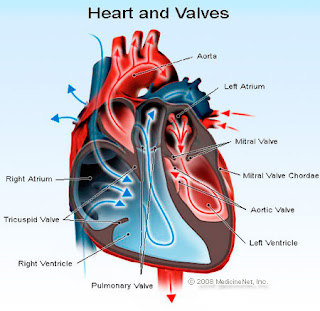Aortic Stenosis - Definition, Etiology, Signs and Symptoms
Aortic Stenosis
Definition
Aortic stenosis is abnormal narrowing of the aortic valve. A number of conditions cause disease resulting in narrowing of the aortic valve. When the degree of narrowing becomes significant enough to impede blood flow from the left ventricle to the arteries, leading to heart problems develop. (Otto, CM, Aortic, 2004; 25:185-187).
Aortic valve stenosis is a narrowing or blockage of the aortic valve. Narrowing of the aortic valve prevents the aortic valve opens maximally thus blocking the flow of blood from the heart to the aorta. Under normal circumstances, the aortic valve consists of three buds that will close and open so blood can get through.
In aortic valve stenosis, the valve usually consists of only two buds so that the hole is narrower and can inhibit blood flow. As a result, the left ventricle must pump more strongly so that blood can pass through the aortic valve.
Etiology
Aortic valve stenosis is a narrowing of the aortic valve preventing blood into the aorta. The cause or etiology of stenosis may vary. However, the most common is RHD (Rheumatic Heart Disease) or what we are familiar with rheumatic fever. Here etiology of aortic valve stenosis details:
1. Congenital Abnormalities
Not many babies born with congenital abnormalities such as narrowing of the aortic valve. Whereas the rest, was born with aortic valve has only two leaves (normal aortic valve consists of three leaves). In the aortic valve with two leaves can not cause significant problems or symptoms until adulthood where he experienced weakness and a narrowing of the valve that requires medical treatment.
2. Calcium buildup on the valve leaflets
As the age of the heart valves may have an accumulation of calcium (calcification of the aortic valve). Calcium is a mineral that can be found in the blood. Along with the blood flow through the aortic valve causing the accumulation of calcium in heart valve which then can lead to narrowing of the aortic valve of the heart. Therefore, aortic stenosis from calcification process common in elderly people over 65 years, but the symptoms, emerging at the age of 70 years.
3. Rheumatic Fever
Complication of rheumatic fever is the presence of sepsis or spreading germs or bacteria through the bloodstream throughout the body, causing the germs or bacteria to heart. When the bacteria reach the aortic valve tissue death occurs on the aortic valve. This dead tissue can cause a buildup of calcium in the future can lead to aortic stenosis. Rheumatic fever can cause damage to more than one heart valve in employed several ways. Heart valve damage may be the inability to open or close the valve even both.
Signs and Symptoms
Aortic valve stenosis can occur from mild to severe stages. Typical symptoms of aortic valve stenosis develops when the valve narrowing worse. Aortic valve regurgitation occurs gradually sometimes even without symptoms of heart because it has to compensate for the decline in the condition of the aortic valve. These clinical manifestations of aortic valve stenosis:
1. Chest Pain
Chest pain is the first symptom in one third of patients and eventually in half of patients with aortic stenosis. Chest pain in patients with aortic stenosis is the same as chest pain (angina) experienced by patients with coronary artery disease (coronary artery disease). In both of these conditions, pain described as pressure under the breastbone that are triggered by exertion and removed the rest. In patients with coronary artery disease, chest pain caused by inadequate blood supply to the heart muscle because the coronary arteries are narrowed. In patients with aortic stenosis, chest pain often occurs without any narrowing of the coronary arteries of the underlying. The thickened heart muscle has to pump against high pressure to push blood through the narrowed aortic valve. It increases the oxygen demand of the heart muscle that exceeds the supply that is sent in the blood, causing chest pain (angina).
2. Fainting (syncope)
Fainting (syncope) associated with aortic stenosis is usually associated with exertion or excitement. These conditions cause relaxation (loosening) of the body's blood vessels (vasodilation), reducing blood pressure. In aortic stenosis, the heart is able to increase the yield to compensate for the fall in blood pressure. Therefore, blood flow to the brain, causing fainting. Fainting can also occur when the cardiac output is reduced by an irregular heartbeat (arrhythmia). Without effective treatment, the average life expectancy is less than three years after the onset of chest pain or symptoms of syncope.
3. Shortness of breath
Shortness of breath from heart failure is a sign of the most unpleasant. It reflects the failure of the heart muscle to compensate for the burden of extreme pressure from aortic stenosis. Shortness of breath is caused by increased pressure in the blood vessels of the lungs caused by the increased pressure required to fill the left ventricle. Initially, shortness of breath occurs only during activity. As the disease progresses, shortness of breath occurs at rest. Patients may find it difficult to lie down without becoming short of breath (orthopnea). Without treatment, the average life expectancy after the onset of heart failure due to aortic stenosis is between 6 to 24 months.

Komentar
Posting Komentar